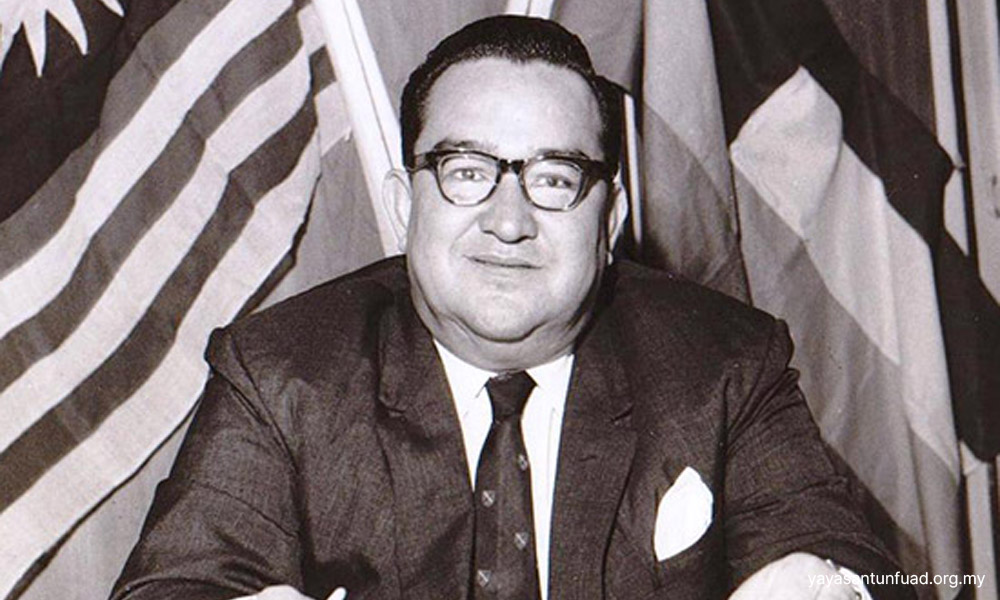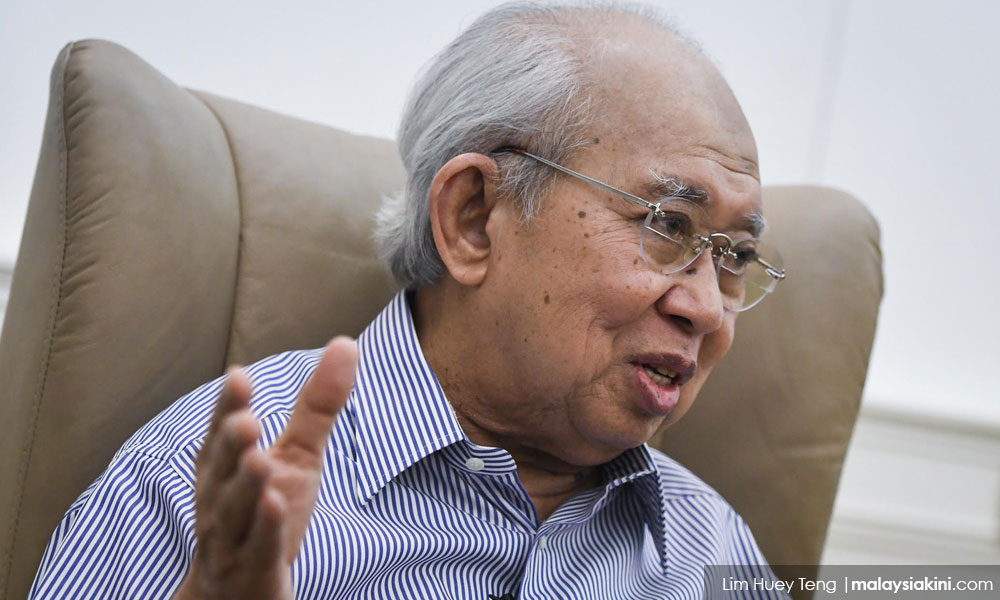IF SO ‘INNOCENT’ – WHY DID ‘MALAYA’ KEEP THE DOUBLE SIX CRASH REPORT TOP SECRET ALL THESE DECADES?
On June 6, 1976, a Nomad plane operated by Sabah Air left Labuan for Kota Kinabalu with many of the state’s most important figures on board.
But upon its approach to the state capital, the GAF N-22B Nomad crashed in the shallow waters of the sea off the district of Sembulan, claiming the lives of 11 people.
The Double Six Crash, as it came to be known based on the date, had a monumental impact on Sabahans at the time.
Fuad Stephens, who had just returned to the Sabah chief minister post after a decade, was the most high-profile victim.
There were many other big names among the deceased, including state ministers Salleh Sulong, Peter Mojuntin and Chong Thien Vun, as well as Fuad’s eldest son Johari Stephens.
This week, nearly 47 years after the tragedy, Prime Minister Anwar Ibrahim announced that the government would declassify the federal investigation report on the 1976 plane crash.

“All this while the government did not decide to declassify the report under the Official Secrets Act.
“The cabinet took into consideration views expressed by Sabahans all these years, and also demands by the next-of-kin, in line with the government’s principle to uphold transparency.
Why did many theories spring up?
The coroner at the time of the initial investigation was Ansari Abdullah who returned an open verdict.
However, there was an implication that human error and the overloading of the plane were to blame.
A few months after the crash, an investigation conducted by Nomad experts and Australian Transport Ministry officials was closed but its report was not made public.
Malaysia’s then deputy communications minister Ali Md Sharif instead made a statement about the investigation findings, saying: “The findings of an investigating team did not reveal any technical errors or sabotage as being the causes of the air crash.
“What they have instead discovered is that the fault was due to human error. It was also revealed that the aircraft’s storage space at the back of the aircraft was loaded with goods above the maximum load.
“As a consequence, this resulted in the aircraft losing control when it attempted to land at the Kota Kinabalu Airport, thus resulting in the accident.”

Many Sabahans felt that their state was being undermined by the federal authority.
Fuad had earlier served as Sabah’s first chief minister in 1963, and also as a federal minister and the state’s governor. He was viewed as its most charismatic politician.
At the time of his death, Fuad had just enjoyed a crushing win over his foe Mustapha with the newly formed Berjaya party – amid tensions between Mustapha and the federal government.
Was oil royalty disputes a factor?
Sabah and the federal government had been at loggerheads over oil royalties. Mustapha’s government had demanded that a high share of Sabah’s oil wealth be channelled back to his state administration.
Mustapha had also engaged in quarrels with the Philippines, which had maintained its claim to Sabah. He also demanded – and received – autonomy when it came to immigration/entry into Sabah.
In the time leading up to the crash, there was also a bomb explosion at a shopping centre, following which the police rounded up and detained hundreds, including Mustapha’s brother‐in‐law.
After the crash, Fuad’s deputy Harris Salleh was sworn in as the chief minister. And just eight days later, on June 14, Harris signed the five percent oil royalty agreement, effectively ceding all rights to Sabah’s rich offshore oil resources to the national oil company, Petronas.
Till today, this low rate of oil royalties being returned to the state for its development is a bone of contention and is cited as a reason for Sabah being one of the poorest states.
Did political tussles between the federal and Sabah governments come into play?
Many in East Malaysia felt that the federal government had tried to replace state leaders in Sarawak (Stephen Kalong Ningkan) and Sabah with more compliant individuals.
One of the subtexts for this is that both states had a Christian majority at the time of the formation of Malaysia and its first chief ministers were also Christian bumiputera (at that time Fuad had yet to convert and was known as Donald Stephens).
Both these ministers were replaced before serving their full terms by members of the Muslim minority and it was a common theory at the time that this was the federal government’s means of asserting control over the states.
Fuad’s daughter Faridah commented on this, saying: “They have done it repeatedly since Malaysia was formed. However, while Fuad was removed as CM in 1964, he was also backed by West Malaysia against Usno’s Mustapha in the 1976 election.”
The fact that Fuad had converted to Islam and Mustapha was having a more combative relationship with the federal government also ran counter to this conspiracy theory.
Is it true Ku Li got off the ill-fated plane?
Years after the event, Harris found himself the victim of nasty rumours that he had foreknowledge of the incident.
On March 1, 2012, the Kota Kinabalu High Court ordered former Sabah chief minister Yong Teck Lee to pay RM1 million after being charged with defaming Harris.
Yong had called for another probe into the incident following reports quoting former finance minister Tengku Razaleigh Hamzah as saying that he was already buckled up on the ill-fated plane when Harris asked him to disembark and join another Nomad flight to Banggi Island to inspect a cattle farm.

Harris’s response was that Razaleigh had never been scheduled to fly to Kota Kinabalu with Fuad but had intended to fly with then Sarawak chief minister Rahman Yaakub to Kudat on the second Nomad plane and then by helicopter to Banggi.
Academician Prof Shamsul Amri Baharuddin was personally affected by the incident.
“My roommate Ishak Atan was on board. He was the private secretary to Razaleigh, who was supposed to be aboard, but at the last moment they switched and it was Ishak who lost his life. It was just fated,” he said.
Former The Star editor PK Katharason concurred, saying: “Because Razaleigh was supposed to be on the plane, and Harris asked him to fly with him, Harris had to contend with much speculation through the years.
“At the trial, the Australian experts said the plane was overloaded, so it is accepted as that.”
Is it possible that flaws in the Nomad design contributed to the crash?
This week Faridah lauded the news that the government will declassify the federal investigation report, but she told Malaysiakini that the Australian government must declassify all documents it has on the Nomad plane.
The GAF Nomad is a utility aircraft that was produced by the Government Aircraft Factories (GAF) of Australia in Melbourne.
Production was discontinued in 1985.
“At the time they said that the plane was overloaded and the crash was therefore due to ‘human error’. The team that came from Australia to investigate the crash also said that no Nomads had crashed before this one.
“We later discovered that this was not true. There had been a Nomad crash in 1973. In fact, in August 1976, just two months after the crash, another Nomad crashed during tests in Avalon, just outside Melbourne. That killed the pilot and a crew member,” she said.

Furthermore, Faridah cited a 1995 documentary by the Australian Broadcasting Commission called ‘Four Corners’ which focused on the poor track record of the Nomad plane.
“The Australian military had refused to fly it by that time and dubbed it ‘the widow maker’ because it was very unstable.
“The documentary refers to a 10-volume report on the Nomad, but the report seems not to have been made public.
“One of the implications of the report is that there is a flaw with the Nomad’s tailplane, which apparently causes the plane to spiral downward when the plane is coming to land,” Faridah said.
A study of the Nomad’s aviation history tells its own tale. Out of the 172 Nomads that were built, no less than 32 suffered hull loss crashes.
In January 2010, a Nomad crash in the Philippines killed eight military personnel, while in 2009 there were other fatal crashes in Lop Buri, Thailand, and Bulungan, Indonesia.
“We will never be absolutely certain about what happened after all these years.
“The government aircraft factory people, who were set the task of investigating it, were not entirely truthful,” claimed Faridah.
“And the evidence has, of course, disappeared. I would still say that the likeliest explanation is the crash occurred because of the faulty plane.”
What triggered this latest attempt to get to the truth?
On March 8, Kota Kinabalu High Court judge Christopher Chin Soo Yin issued a mandamus order, which directed the government to initiate the required steps to make the report public.
Chin gave the government until June 8 to comply with the order. On March 15, the government filed an appeal against the decision, making it seem like the situation would be dragged on further.
However, the announcement by the Anwar-led government this week has given rise to hopes that more shall be revealed.
MKINI
.
